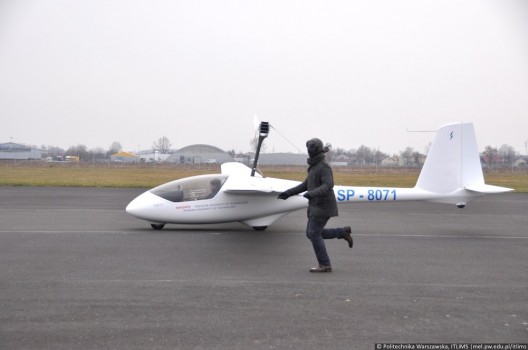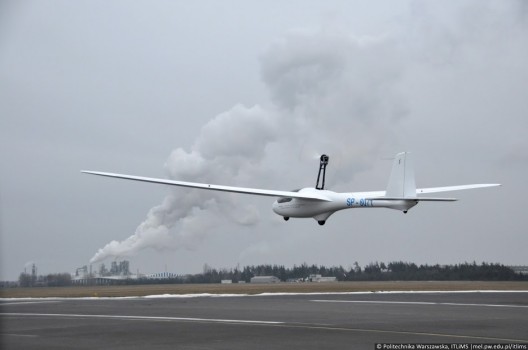Michael Friend, Boeing Technology Director, met Maciej Kalwara a faculty member in mechanical engineering and aerodynamics from Rzeszow University, Poland at the 2012 ILA Berlin, or Berlin Air Show. Maciej showed him the AOS-71 electric motorglider – a first in Poland. The airplane made its initial test flights just weeks ago, perfectly according to the test pilot.
A joint project between Rzeszow and Warsaw Universities of Technology and a derivation of the PW-6 tandem sailplane, the AOS-71 has a Sineton A30K016, 30 kilowatt (continuous power) motor. As shown in the video and pictures from Maciej, the flight looked smooth, lasted 20 minutes and achieved an altitude of 250 meters (820 feet). The airplane landed with 30 percent of its battery’s energy still available despite the climb and -17° C/-14° F temperature.
- Wind chill factor on wing runner must have been numbing
An outgrowth of the Universities’ ultralight glider program, the 16.6 meter span sailplane has an empty weight of 385 kilograms (847 pounds) ready-to-fly, including 80 kilograms (176 pounds) of lithium-polymer batteries. Its carbon fiber structure allows a never-exceed velocity (Vne) of 220 kilometers per hour (136.4 mph). The AOS-71 has a best lift-to-drag ratio of 30:1 at 110 km/hr (68.2 mph) and a stall speed of 78 km/hr (48.4 mph).
A full test program will take place in the spring, when Maciej promises a “normal” exploration of battery performance.
As explained in the newsletter Advanced In-Flight Measurement 2, “The AOS-71 program, initiated by the intercollegiate team, is a direct continuation of the ULS (Ultra Light Glider) program which is coordinated in The Faculty of Power and Aeronautical Engineering of Warsaw University of Technology for more than 30 years.”
A descendant of the PW-6, the AOS-71 inherits its main aerodynamic and structural features, with lighter carbon-fiber structures replacing the original’s glass-fiber units. According to AIM2, “The wing geometry has not changed but the new design is based on a carbon/epoxy composite structure (the PW 6 was built with glass fiber). [This probably accounts for its nearly equal weight with the PW-6 without motor and batteries.] The AOS design is based on two engine configurations: conventional piston and electric engine.
“The idea behind the AOS-71 project is the allocation of a test bed for many experiments in the area of aeronautical engineering. The main fields of operation of the AOS-71 motorglider are studies and applications of innovative, light composite airframes; testing of damage detection methods and their propagation observations in composite structures as well as the design and construction of ecological electric drives; onboard data acquisition and telemetric tests, research and development of new measurement methods and equipment and a flying wind tunnel for airfoils and small flying objects. Other objectives of this project are the preparation, testing and validation of numerical models as well as testing the effectiveness of signals reception for navigation systems. A modular structure of the cockpit allows the installation of new equipment and eases the preparation of the motorglider for other in-flight tests. During the realization of AIM project the AOS-71 will be used for IPCT (for measurements of structure deformations and the validation of MES calculations by comparison of their results) and investigation of the laminar – turbulent transition and separation on airfoils with the help of an infrared observations system.”
This use of advanced test procedures should help develop an even more advanced next generation of sailplanes and light aircraft. In the meantime, the AOS-71 marks a significant first for Polish Universities.



Comments 1
The family resemblance to the PW6 is very apparent, but the side-by-side cockpit is a big change!